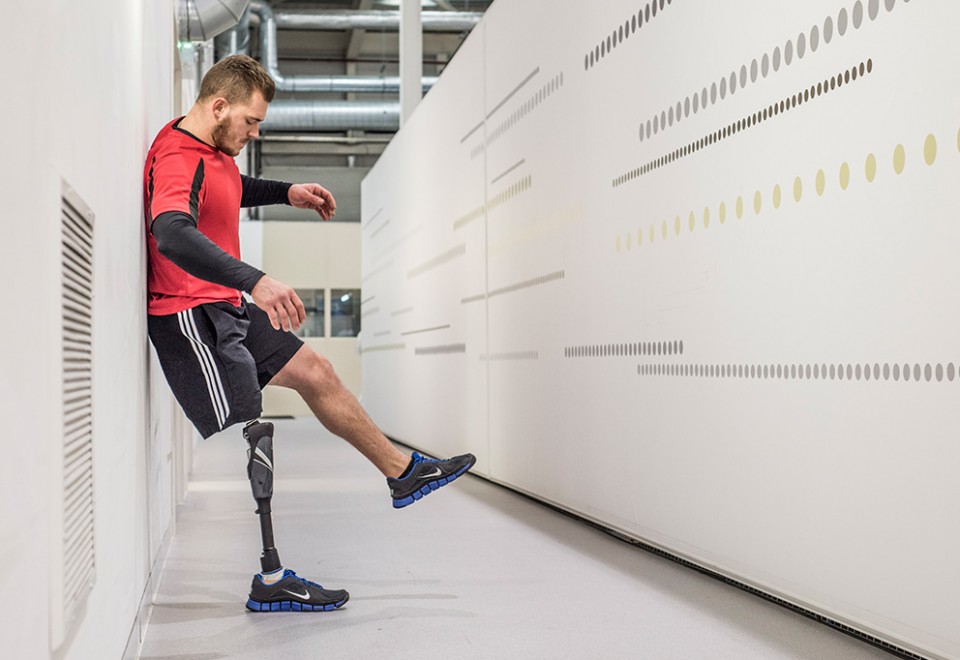Smart Prosthetic Device Is a Laudable IoT Case StudySmart Prosthetic Device Is a Laudable IoT Case Study
We sit down with the head of research at the prosthetics firm Blatchford to discuss the company’s Linx integrated smart prosthetic limb system.
October 28, 2019

In late September, I received an invitation to write about advanced prosthetic technology from Blatchford, a UK-based medical device company. After asking for a recommendation for an Internet of Things–related angle related to the company’s products, I learned of the company designed a programmable microprocessor-enabled integrated limb known as the Linx.
The Linx device has won several awards, including the Royal Academy of Engineering’s MacRobert Award, an annual award for innovation in engineering in 2016. In 2017, the product won the “Best in Show Award” in the Medical Design Excellence Awards.
In this Q&A, David Moser, head of research at Blatchford, shares why the Linx device is symbolic of the type of transformation many products are undergoing. The Linx is a smart, connected device that gathers data about its user and environment to optimize performance. Specifically, it uses four microprocessors in conjunction with seven situational awareness sensors to enable natural movement. There is also a system of systems dimension: The ankle and knee communicate with each other 400 times per second. In a single day, the device will make adjustments more than 2,000 times to accommodate its environment.
[Industrial IoT World is the event where companies learn how to scale IIoT for integration, innovation and profit. Save $200 on your conference pass with VIP code “IOTWORLDTODAY.”]
Why is the Linx smart prosthetic limb important from an IoT-related design perspective?
Moser: It’s a good one to talk about because, in some ways, it represents the change that is happening in not just prosthetics, but lots of industries. And that has to do with data.
In our field, we have microprocessor knees and ankles. To a large extent, these products are independent from one another. Based on these platforms, we decided, several years ago, to integrate them. That meant they would be sharing data, as well as control information. I think that opened up a new generation of prosthetics.
When you combine systems, you end up with a much richer data set of information on which to make decisions. For example, these microprocessor limbs are constantly monitoring how a person’s moving, how fast they’re walking, what kind of environment they are walking in, and making real-time adjustments to the limb. If you’re able to direct more information to that problem, then you’ve got a better chance of coming up with a control system that’s capable of dealing with the variation you see in everyday life.
Can you summarize how the microprocessors in the Linx mimic a natural limb?
Moser: When you are walking around in normal life, we’re continuously changing direction and speed. We’re walking in all sorts of different terrains, and the body is naturally adjusting itself, and the way legs move so that you can get around with the least amount of energy possible.
The Linx needs to accommodate changes to the environment in a biomechanical way so that users don’t exert so much energy. And that’s a difficult problem because you’re dealing with such a huge variation. If you imagine the activities of daily living — every move that you do — thousands and thousands of steps — how do you detect these changes and accommodate them?
The way to do it is to integrate the components of the limb. Rather than looking at products or joints individually, you can leverage all that new information. And what you end up with is a leg which behaves in a much more natural way — able to predict and move in a coordinated way. That’s another important thing. And in our limbs, the movement is very coordinated. Essentially our microprocessor foot would be making its own decisions in complete awareness of what a microprocessor knee would be doing. How the foot interacts with the ground will affect what the knee needs to do.
The whole thing is a system. The idea behind the Linx was: Let’s take a step backward and look at the problem from an integrated point of view — from a systems point of view, and a data point of view. The key is in integration and in leveraging data.
How does the Linx learn from user feedback?
Moser: We are dealing with a control system that involves the human in the loop. When, for example, a user places his or her foot on the ground, how they put their foot on the ground, and what kind of terrain it is, will affect what they feel and then how they will react to what they feel.
Let’s say the leg is adjusting in a way that can accommodate going down a ramp. Because it reacts to the sensation that the patients are feeling, it makes the whole activity much easier and much safer. If it wasn’t able to do that, what would happen is the leg would be trying to knock the user off balance. And then, the user would have to try to reestablish their balance or to provide more control and energy. The user would make a cognitive effort to try and stay balanced. If you have to do that sort of thousands of times a day on every step, then it becomes important for the user.
The idea behind the latest microprocessor controls is really to remove that burden so people can walk around in everyday life, not having to think so much over what kind of environment they’re walking in. The better the limb can adjust, the less the user needs to adjust — the less energy they expend. And if you multiply that over the course of the whole day, then it can be quite significant. Every step becomes a little bit easier. And at the end of the day, if you had done 6,000 or 10,000 of steps, they’ve all been a little bit easier than they were before. Then, the technology has quite a significant effect on the user’s life.
Does the system automatically adjust if the user is, say, cycling?
Moser: Not so much with cycling because that is a very specific activity. Users can go on to an app, for example, and switch it into cycling mode.
But in terms of normal walking and everyday activities, and by that, I mean sitting up, standing, changing direction, changing speed, walking up and down stairs, walking over curbs, and on-ramps, for example, that is all automated. You don’t need to interrupt the leg or change something. The sensors are on board, and the control system can detect these changes and the person’s gait. It can sense how they walk, but also the environment they are walking in. And it makes changes to the knee and ankle, which better suits the requirements of those activities.
Can you tell me more about the app the Linx has?
Moser: All of the microprocessor products generally have an app with them. They use Bluetooth technology.
The micro-control system is programmed by the user because each person walks slightly differently and will have different capabilities. Therefore, you can adjust the settings of the leg — how stiff they want the knee to be, for example, how fast they walk, how quickly the knee swings through. Or how stiff they want the ankle to feel, for example. That can all be personalized to the user.
Usually, what happens once these adjustments have been made for a set of controlled conditions, is the system will learn what the person’s preferred gait is — how fast they walk and how they change walking speed. The system will also understand what the walking environment is, and then that information is all combined later on in the control system. It is basically being personalized.
About the Author
You May Also Like






